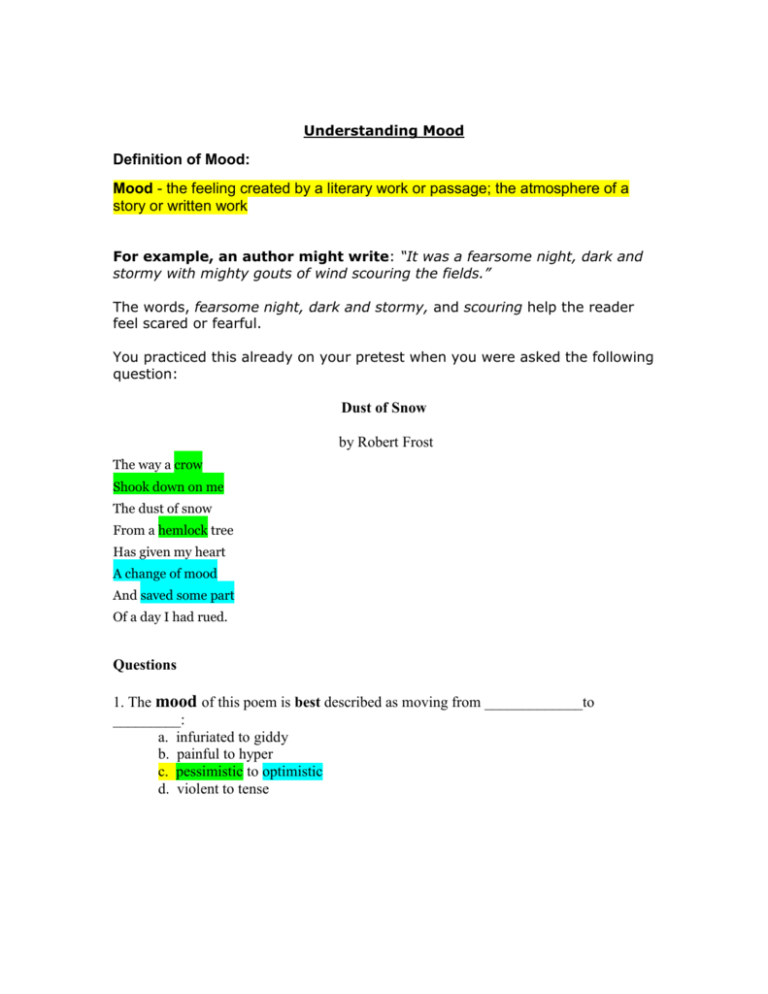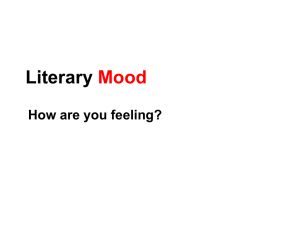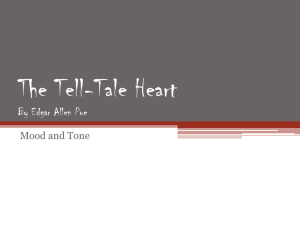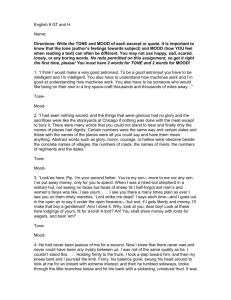Understanding Mood
advertisement

Understanding Mood Definition of Mood: Mood - the feeling created by a literary work or passage; the atmosphere of a story or written work For example, an author might write: “It was a fearsome night, dark and stormy with mighty gouts of wind scouring the fields.” The words, fearsome night, dark and stormy, and scouring help the reader feel scared or fearful. You practiced this already on your pretest when you were asked the following question: Dust of Snow by Robert Frost The way a crow Shook down on me The dust of snow From a hemlock tree Has given my heart A change of mood And saved some part Of a day I had rued. Questions 1. The mood of this poem is best described as moving from _____________to _________: a. infuriated to giddy b. painful to hyper c. pessimistic to optimistic d. violent to tense 2. What evidence from this piece helps you determine the mood of the piece? In the poem, “Dust of Snow,” by Robert Frost, the mood moves from pessimistic to optimistic. The evidence that proves the poem’s mood is found in the crow shaking snow on the speaker in the beginning of the poem, which is negative, or pessimistic; but the speaker’s mood is changed to a more optimistic outlook by the end of the poem as shown in the use of the phrase “change of mood” and “saved some part.” Definition of Tone: Tone – writer's attitude toward his or her subject matter revealed through diction, figurative language, and organization of the sentences. For example, if you read a sentence like the following: People who, acting like pawns, blindly follow government laws and government officials are surely doomed to lead a prison-like life, wasting away in the drudgery of duty, we know the author is using an indignant tone because of the words and phrases in bold. You practiced this already on your pretest when you were asked the following question: Directions: Read the short story excerpt below. Then answer the questions that follow. Circle the best answer for the multiple-choice questions. For short answer questions, please write your answer in complete sentences, referencing the title of the piece and the piece’s author. “The Pond” The girls were playing in the pond, splashing each other and trying to catch fish with their hands. They were having fun, but kept looking over their shoulders at the looming forest. The long grass of the field kept moving and they sort of felt like they were being watched… About a half hour passed and still the girls kept checking the field for movements. It seemed like a pair of dark eyes was on them. They even considered going back inside, but that would mean homework time. So they continued splashing, but with caution now. Their eyes hardly left the field. By Shimi Shesh Questions 3. The tone of this excerpt is best described as: a. humorous b. direct c. ominous d. detached 4. What evidence from this piece helps you determine the tone of the piece? In the narrative, “The Pond,” by Shimi Shesh, the tone is ominous. The author uses phases like, “looking over their shoulders,” and “being watched.” Such phases certainly prove how the author felt ominous or threatened by the situation. Furthermore, the piece includes words and phrases like, “looming forest,” “dark eyes,” and “caution.” By using such words, the Shimi Shesh continues to emphasize the ominous tone of the piece because words like, looming, dark, and caution all carry a negative connotation. Such examples are only a few of the many examples that exist to demonstrate mood and tone. Also, don’t forget the examples we viewed through watching the recut movie trailers. The editors of these trailers are like authors, and the clips, music, effects, and narration that the editor selected all help express his or her attitude towards the subject, while the same choices affected the reader to create a mood. In the movie trailers: 1. images and color tone = word choice and phrasing and details included in books 2. music = sentence fluency and rhythm in writing 3. heavy drums, fast-paced music, and attention-grabbing action = short punchy sentences that create tension and suspense in a book mood = emotional effect that the text creates for the audience POSITIVE MOOD WORDS amused awed bouncy calm cheerful chipper confident contemplative content determined dignified dreamy ecstatic empowered energetic enlightened enthralled excited exhilarated flirty giddy grateful harmonious hopeful hyper idyllic joyous jubilant liberating light-hearted loving mellow nostalgic optimistic passionate peaceful playful pleased refreshed rejuvenated relaxed relieved satiated satisfied sentimental silly surprised sympathetic thankful thoughtful touched trustful vivacious warm welcoming NEGATIVE MOOD WORDS aggravated annoyed anxious apathetic apprehensive barren brooding cold confining confused cranky crushed cynical depressed desolate disappointed discontented distressed drained dreary embarrassed enraged envious exhausted fatalistic foreboding frustrated futile gloomy grumpy haunting heartbroken hopeless hostile indifferent infuriated insidious intimidated irate irritated jealous lethargic lonely melancholic merciless moody morose nauseated nervous nightmarish numb overwhelmed painful pensive pessimistic predatory rejected restless scared serious sick somber stressed suspenseful tense terrifying threatening uncomfortable vengeful violent worried tone = speaker’s attitude POSITIVE TONE WORDS admiring adoring affectionate appreciative approving bemused benevolent blithe calm casual celebratory cheerful comforting comic compassionate complimentary conciliatory confident contented delightful earnest ebullient ecstatic effusive elated empathetic encouraging euphoric excited exhilarated expectant facetious fervent flippant forthright friendly funny gleeful gushy happy hilarious hopeful humorous interested introspective jovial joyful laudatory light lively mirthful modest nostalgic optimistic passionate placid playful poignant proud reassuring reflective relaxed respectful reverent romantic sanguine scholarly self-assured sentimental serene silly sprightly straightforward sympathetic tender tranquil whimsical wistful worshipful zealous NEUTRAL (+, -, or neutral) commanding direct impartial indirect meditative objective questioning speculative unambiguous unconcerned understated NEGATIVE TONE WORDS abhorring acerbic ambiguous ambivalent angry annoyed antagonistic anxious apathetic apprehensive belligerent bewildered biting bitter blunt bossy cold conceited condescending confused contemptuous curt cynical demanding depressed derisive derogatory desolate despairing desperate detached diabolic disappointed disliking disrespectful doubtful embarrassed enraged evasive fatalistic hostile impatient incredulous indifferent indignant inflammatory insecure insolent irreverent lethargic melancholy mischievous miserable mocking mournful nervous ominous outraged paranoid pathetic patronizing pedantic pensive pessimistic pretentious psychotic resigned reticent sarcastic sardonic scornful self-deprecating selfish serious severe sinister skeptical sly solemn somber fearful forceful foreboding frantic frightened frustrated furious gloomy grave greedy grim harsh haughty holier-than-thou hopeless stern stolid stressful strident suspicious tense threatening tragic uncertain uneasy unfriendly unsympathetic upset violent wry Important Terms: Tone Words: Mood Words: Tone in literature tells us how the author thinks about his or her subject. The author's style conveys the tone in literature. Tone is the author's attitude toward story and readers. Mood is the effect of the writer's words on the reader. Mood is how the writer’s words make us feel.







